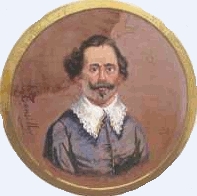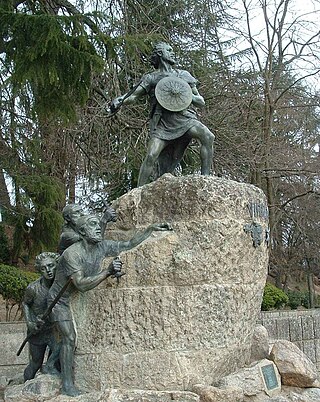In poetry, a hendecasyllable is a line of eleven syllables. The term may refer to several different poetic meters, the older of which are quantitative and used chiefly in classical poetry, and the newer of which are syllabic or accentual-syllabic and used in medieval and modern poetry.

Ludovico Ariosto was an Italian poet. He is best known as the author of the romance epic Orlando Furioso (1516). The poem, a continuation of Matteo Maria Boiardo's Orlando Innamorato, describes the adventures of Charlemagne, Orlando, and the Franks as they battle against the Saracens with diversions into many sideplots. The poem is transformed into a satire of the chivalric tradition. Ariosto composed the poem in the ottava rima rhyme scheme and introduced narrative commentary throughout the work.

John Anthony Burgess Wilson, who published under the name Anthony Burgess, was an English writer and composer.
A tercet is composed of three lines of poetry, forming a stanza or a complete poem.
The Spenserian stanza is a fixed verse form invented by Edmund Spenser for his epic poem The Faerie Queene (1590–96). Each stanza contains nine lines in total: eight lines in iambic pentameter followed by a single 'alexandrine' line in iambic hexameter. The rhyme scheme of these lines is ABABBCBCC.

Orlando furioso is an Italian epic poem by Ludovico Ariosto which has exerted a wide influence on later culture. The earliest version appeared in 1516, although the poem was not published in its complete form until 1532. Orlando furioso is a continuation of Matteo Maria Boiardo's unfinished romance Orlando innamorato. In its historical setting and characters, it shares some features with the Old French La Chanson de Roland of the eleventh century, which tells of the death of Roland. The story is also a chivalric romance which stemmed from a tradition beginning in the late Middle Ages and continuing in popularity in the 16th century and well into the 17th.
Assonance is the repetition of identical or similar phonemes in words or syllables that occur close together, either in terms of their vowel phonemes or their consonant phonemes. However, in American usage, assonance exclusively refers to this phenomenon when affecting vowels, whereas, when affecting consonants, it is generally called consonance. The two types are often combined, as between the words six and switch, which contain the same vowel and similar consonants. If there is repetition of the same vowel or some similar vowels in literary work, especially in stressed syllables, this may be termed "vowel harmony" in poetry.
Ottava rima is a rhyming stanza form of Italian origin. Originally used for long poems on heroic themes, it later came to be popular in the writing of mock-heroic works. Its earliest known use is in the writings of Giovanni Boccaccio.
Rhyme royal is a rhyming stanza form that was introduced to English poetry by Geoffrey Chaucer. The form enjoyed significant success in the fifteenth century and into the sixteenth century. It has had a more subdued but continuing influence on English verse in more recent centuries.
Terza rima is a rhyming verse form, in which the poem, or each poem-section, consists of tercets with an interlocking three-line rhyme scheme: The last word of the second line in one tercet provides the rhyme for the first and third lines in the tercet that follows. The poem or poem-section may have any number of lines, but it ends with either a single line or a couplet, which repeats the rhyme of the middle line of the previous tercet.

John Hookham Frere was an English diplomat and author.
William Tennant was a Scottish scholar and poet.

In English literature, Don Juan, written from 1819 to 1824 by the English poet Lord Byron, is a satirical, epic poem that portrays the Spanish folk legend of Don Juan, not as a womaniser as historically portrayed, but as a victim easily seduced by women. As genre literature, Don Juan is an epic poem, written in ottava rima and presented in 16 cantos. Lord Byron derived the character of Don Juan from traditional Spanish folk legends; however, the story was very much his own. Upon publication in 1819, cantos I and II were widely criticised as immoral because Byron had so freely ridiculed the social subjects and public figures of his time. At his death in 1824, Lord Byron had completed 16 of 17 cantos, whilst canto XVII remained unfinished.
Beppo: A Venetian Story is a lengthy poem by Lord Byron, written in Venice in 1817. Beppo marks Byron's first attempt at writing using the Italian ottava rima metre, which emphasized satiric digression. It is the precursor to Byron's most famous and generally considered best poem, Don Juan. The poem contains 760 verses, divided into 95 stanzas.
Carroll & Graf Publishers was an American publishing company based in New York City, New York, known for publishing a wide range of fiction and non-fiction by both new and established authors, as well as issuing reprints of previously hard-to-find works. It was closed in 2007.
Graham K. Burgess is an English FIDE Master of chess and a noted writer and trainer. He became a FIDE Master at the age of twenty. He attended Birkdale High School in Southport, Merseyside. In 1989 he graduated from the University of Cambridge with a degree in mathematics. In 1994 he set a world record by playing 510 games of blitz chess in three days, winning 431 games and drawing 25.

Luigi Tansillo was an Italian Late Renaissance poet. Tansillo deserves a special place in the history of Italian poetry, for he constitutes the link between the classical lyric of the Cinquecento and the baroque lyric of the Seicento.
The Vision of Judgment (1822) is a satirical poem in ottava rima by Lord Byron, which depicts a dispute in Heaven over the fate of George III's soul. It was written in response to the Poet Laureate Robert Southey's A Vision of Judgement (1821), which had imagined the soul of king George triumphantly entering Heaven to receive his due. Byron was provoked by the High Tory point of view from which the poem was written, and he took personally Southey's preface which had attacked those "Men of diseased hearts and depraved imaginations" who had set up a "Satanic school" of poetry, "characterized by a Satanic spirit of pride and audacious impiety". He responded in the preface to his own Vision of Judgment with an attack on "The gross flattery, the dull impudence, the renegado intolerance, and impious cant, of the poem", and mischievously referred to Southey as "the author of Wat Tyler", an anti-royalist work from Southey's firebrand revolutionary youth. His parody of A Vision of Judgement was so lastingly successful that, as the critic Geoffrey Carnall wrote, "Southey's reputation has never recovered from Byron's ridicule."
La Spagna, also called La Spagna in rima, is a 14th-century Italian epic attributed to the Florentine Sostegno di Zanobi and likely composed between 1350 and 1360. The poem is in ottava rima, composed of 40 cantos, each of about 40 octaves. The work is an adaptation of the story of Charlemagne's battles in Spain and the adventures of his nephew, the paladin Orlando (Roland), including the tale of his mortal duel with Ferraguto and his ultimate death at Roncesvalles.

Viriato Trágico is an epic poem by Portuguese author Brás Garcia de Mascarenhas.







